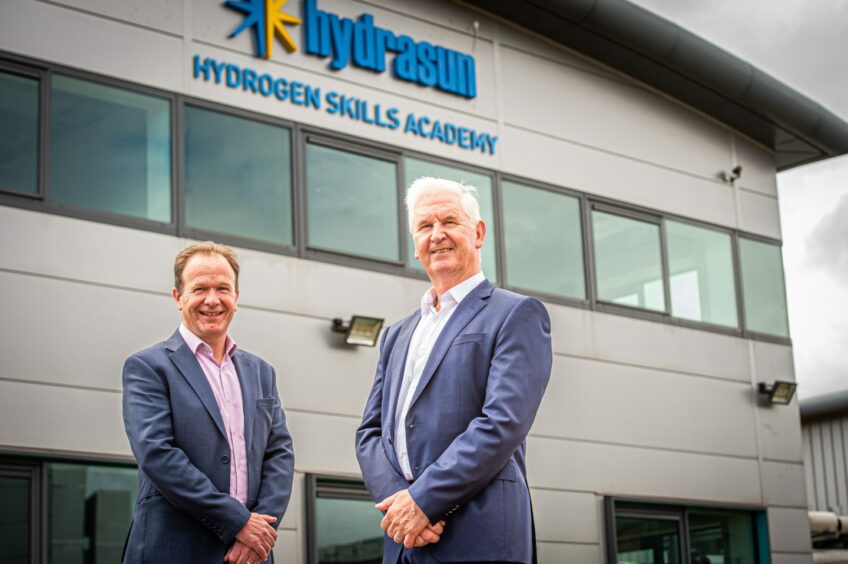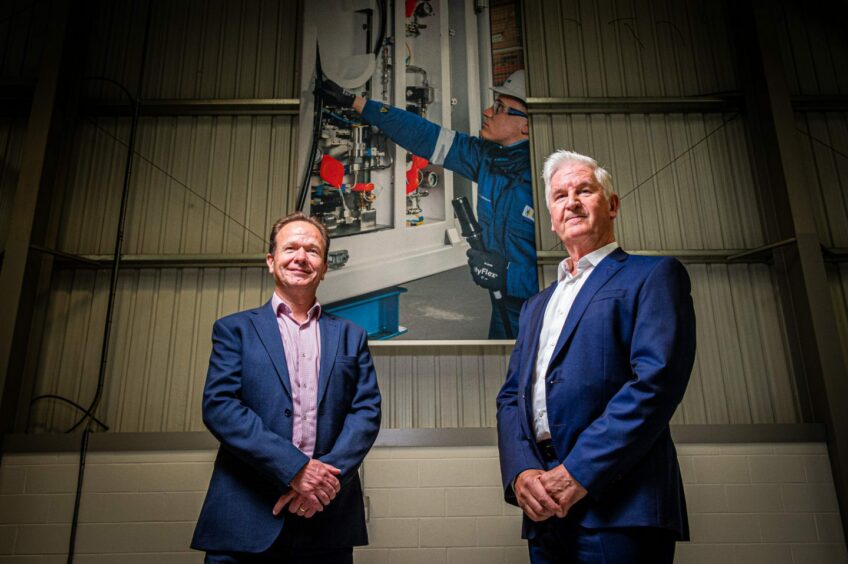
Hydrasun has unveiled a major drive on hydrogen technology, with a clutch of initiatives including the launch of a new skills academy, a recruitment push, and a new acquisition on the way.
The firm has also signed an agreement with Japanese tech giant Panasonic on a potential demonstration project for industrial building decarbonisation at Aberdeen’s Energy Transition Zone (ETZ).
CEO Bob Drummond told Energy Voice that north-east headquartered Hydrasun is expected to make a new acquisition in the coming weeks which will “immediately more than double” its sales from the low-carbon technology.
As things stand, hydrogen turnover is already projected to be £5-6 million in 2022 for the firm, up from £2m last year.
Meanwhile Hydrasun’s projection for overall business growth is at least 25% this year, with estimated turnover of £90-£100m.
Details of the acquisition are under wraps but Mr Drummond said the move will bolster its position in the green hydrogen transport space, if successful.
Skills academy
Hydrasun is meanwhile planning to open its purpose-built new skills academy at its headquarters in Aberdeen’s Gateway Business Park in September.
The facility has the lofty and ultimate aim of having “the best hydrogen safety course in the world”.
First priorities for the opening courses – designed for customer employees and Hydrasun’s own team making a skills transition – include hydrogen safety, pressure testing and systems assembly, which will be followed by control systems.
It adds to new sites and equipment in Glasgow and Aviemore this year which, backed up by £500,000 of Scottish Enterprise funding, represents well in excess of £1m investment.
The firm is also planning new facilities in 2022 in Teesside and Rotterdam, bolstering the hopper of projects, and evaluating opportunities for a new facility in Germany.
Mr Drummond noted that this comes almost exactly a year on since private equity group SCF Partners came in as a backer.
This, coupled with the improved dynamics in the oil and gas industry, has allowed the board to “position the company in much more of a positive offensive position, rather than a prudent defensive position” as many supply chain firms have had to do coming out of the downturn.
Recruitment drive
Hydrasun launched its hydrogen division six years ago, and has since then delivered around 30 projects – almost all of which involve green hydrogen linked to transport and mobility. That includes the first production, storage and refuelling system for a public transport company in France.
As that work ramps up, the firm is in “a really intense period of recruitment”, with employee numbers up by 40 since last year – comprised of engineers, apprentices and graduate trainees – with 17 vacancies currently open, over half of which are hydrogen-related.
Hydrasun employs 436 people, with 351 in Scotland of which 244 are in its home base of Aberdeen.
Mr Drummond is bullish about the potential for north-east Scotland in the space, thanks to efforts of groups like OEUK and North East of Scotland Hydrogen Ambition steering group
“I think that we really do have an opportunity to be a global leader in hydrogen.
“We as a company fundamentally believe that, in there’s such a phenomenal strategic opportunity here in our own doorstep.”
Sceptics and ‘Tipping Point’
Yet there remains a faction of people – academics, NGOs and otherwise –adamant that hydrogen will not take off as a major market, and that areas like electrification are the more cost-effective and appropriate alternative.
“I can understand why there is there is a continued scepticism, when you look back even just three years ago, the economics at the time, you could see the stark differences between conventional energy sources and hydrogen.
“Then you look at what’s happened in the past 12 months to gas prices, gas supply, I think the whole question around security and sustainability of supply combined with the phenomenal price shock that we’ve seen has caused a fundamental shift in the economics.
“The second thing, particularly in green hydrogen, as the technology evolves and scales up, the unit costs are coming down really quickly. The general closing of the gap has been really significant in the past 12 months.”
A major “tipping point”, as Mr Drummond puts it, has been the “rapidly accelerating policy shift” in Germany, the Netherlands, France and followed by the UK, which is “overlapping really nicely” with Hydrasun’s customers’ own transitions from conventional oil and gas into renewables.
Panasonic
Activity in the north-east of Scotland such as the Aberdeen Hydrogen Hub, the ERM Dolphyn project, Vattenfall HT1, the ETZ and Acorn CCS is drawing international attention, according to the Hydrasun boss.
“I’ll use that MoU with Panasonic as one example of that,” Mr Drummond said, referring to the agreement signed with the Japanese giant in recent weeks.
Together they are assessing a pilot project on building decarbonisation the the ETZ – the zone backed by Sir Ian Wood in the south of Aberdeen – using Panasonic fuel cells instead of conventional heating sources.
“The name Panasonic is obviously a phenomenally recognised and respected global company, and for them to be looking at Aberdeen as a key target area for the pilot demonstration of their new fuel cell range. I think that that in itself is a really powerful signal.”
Engine Room
Taken together, “it’s hard to imagine a better opportunity than we’ve got from a regional perspective,” Mr Drummond argued.
“When you look a the human resource that we have, the natural resource that we have and the capability that we’ve built up over 50 years’ experience in the oil and gas industry.
“You put those three things together, I mean what an opportunity, it’s here, it’s get in after it time.”
But a crucial point, he noted, is that it’s the conventional business of North Sea oil and gas which is allowing Hydrasun to drive investment in this low-carbon technology.
“Having a buoyant oil and gas market – particularly as an Aberdeen based and very still North Sea-focused and North Sea-dependent company – is still effectively the engine room of change for our company, it’s the driver of the speed of transition.
“That’s an important point from a supply chain perspective.”

 © Supplied by Wullie Marr/ DC Thom
© Supplied by Wullie Marr/ DC Thom © Bloomberg
© Bloomberg